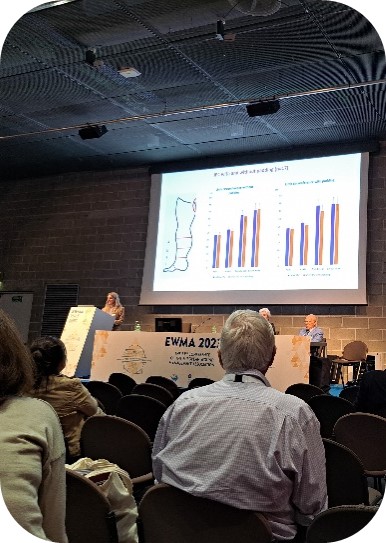What better way than discovering a city by bike? Maybe in Milan there is… Even though I enjoyed the perfect weather and the beautiful views, I was also quite happy to arrive safely (including my laptop) at the conference after navigating Italian traffic. However, fully admiring the spectacular conference building was for after the International Compression Club (ICC) meeting at the EWMA conference.

First we wanted to hear all about the latest developments in compression in patients with edema. However, you cannot have a future without looking at the past. Therefore, a nice overview was given about the evolution of compression therapy. If you thought that bandaging is an old technique, then you were right. Seems like our ancient Egyptian friends were already familiar with this technique. It is not a coincidence that patients often report how they feel like a mummy with the bandages on.
However, throughout the years people have been trying to figure out how to make compression therapy more comfortable and effective. Dr. Mieke Flour mentioned in her presentation that the pressure given by the compression system is one of the important characteristics to make it effective. This was also confirmed by the presentation of Dr. Andreas Nilsson who indicated the importance of measuring this interface pressure during research. Luckily, there is some innovation in wearable biosensors to evaluate this interface pressure. According to the presentation of Willi Chi, advances in these wearable biosensors include improved material, applicability and wireless communication. Andrew Cameron also presented a wearable pressure sensing device which measures the interface pressure underneath the bandages at three places at the lower limb and which sends the necessary information to the associated App. A small study with this pressure sensing device showed a pressure loss already after a few hours. This has also been seen in previous research. Furthermore, they also saw that the position of the foot in 90° while applying the bandages resulted in a better interface pressure than when the foot was held in more dorsiflexion.
Since interface pressure is influenced by the position of the limb, the Aero-WrapTM was developed. Prof. Dr. Giovanni Mosti presented this device, from which the interface pressure can be adapted according to the position of the limb by a compression pump connected to an internally sewed bladder. Another dynamic compression device for upper limb lymphedema was presented by prof. dr. Jean Paul Belgrado. This device gives additional to a vertical pressure also a horizontal pressure following the direction of the lymph flow with some first positive result on the volume. On the contrary, the intermittent pneumatic compression systems are mainly giving vertical pressure. According to the study of Dr Marzanna Zaleska, in patients with lower limb lymphedema can adding padding material with vertical stitches underneath the intermittent pneumatic device help to form new tissue channels improving the transport of the lymph.

Another form of compression therapy which was discussed, were adjustable wraps. Dr. Schingale showed some nice results of the application of these adjustable wraps in very complex cases when traditional multilayer bandaging is not feasible. According to the study of Dr. Taha, the adjustable wrap Readywrap® well maintained the stiffness after 5 hours, but with a median decrease of the resting pressure of 28mmHg.
We do not always have to look very far to find solutions and innovation in compression therapy. Prof. dr. Lieva Van Langenhove of the university of Ghent in Belgium performs research about smart textiles. She reported the importance of a good balance between comfort, protection and efficiency of compression material. This could be achieved with the help from individual body scans. The cooperation between textile engineers, industry and specialists in lymphology sounds very promising to enhance this project.
Thanks to all of these developments compression therapy continues to improve. Curious about the other developments and things we learned during the conference meeting? Part 2 is coming soon…
An-Kathleen